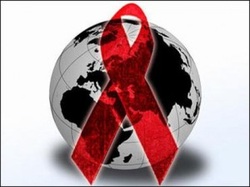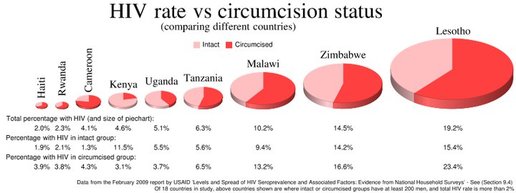
Where Circumcision Doesn't Prevent HIV
There's currently a lot of hype surrounding circumcision and the transmission of HIV. The word on people's lips is that "circumcision reduces HIV transmission by 60%." The claim is based on the result of three major "studies" that were carried out in Africa, but there are a few confounding factors that bring the validity of these so-called "studies" into question. One of the greatest confounding factors in these studies is empirical evidence to the contrary; real world data from countries where circumcision is already a widespread practice and studies with contrary results.
Countries in Africa
Let's begin with countries in Africa, where these "studies" would be relevant. According to demographic health surveys performed in other countries in Africa, HIV transmission was prevalent in circumcised men in at least 6 different countries. I go one by one, analyzing some of the commentary in these surveys, some of which seems to be revealing of the researchers' bias.
Cameroon
In Cameroon, where 91% of the male population is circumcised, the ratio of circumcised men vs. intact men who contracted HIV was 4.1 vs. 1.1. (See p. 17)
www.measuredhs.com/pubs/pdf/FR163/16chapitre16.pdf
Ghana
"...the vast majority of Ghanaian men (95 percent) are circumcised... There is little difference in the HIV prevalence by circumcision status..." (1.6 vs 1.4 See p. 13)
www.measuredhs.com/pubs/pdf/FR152/13Chapter13.pdf
Lesotho
In Lesotho, 23% of the men are circumcised, and the ratio circumcised men vs. intact men who contracted HIV was 22.8 vs 15.2.
"The relationship between male circumcision and HIV levels in Lesotho does not conform to the expected pattern of higher rates among uncircumcised men than circumcised men. The HIV rate is in fact substantially higher among circumcised men (23 percent) than among men who are not circumcised (15 percent). Moreover, the pattern of higher infection rates among circumcised men compared with uncircumcised men is virtually uniform across the various subgroups for which results are shown in thetable. This finding could be explained by the Lesotho custom to conduct male circumcision later in life, when the individuals have already been exposed to the risk of HIV infection. (Additional analysis is necessary to better understand the unexpected pattern in Table 12.9.)" (p. 13)
What is disturbing here is that it seems researchers grope for a reason to dismiss these results because they are not what they are looking for; a positive result for circumcision. The above is an interesting defense of male circumcision, given the fact that the latest "studies," if they can even be called that, observed HIV trasmission in men circumcised as adults. Then again, this demographic health survey was conducted in 2004, BEFORE the newer "studies" in 2006. None the less, the unproven assertion that "circumcision is only effective in reducing the risk of HIV when done in infancy" persists in some circles.
www.measuredhs.com/pubs/pdf/FR171/12Chapter12.pdf
Malawi
In Malawi, 20% of the male population is circumcised. The ratio of circumcised vs. intact men who contracted HIV was 13.2 vs 9.5.
"The relationship between HIV prevalence and circumcision status is not in the expected direction. In Malawi, circumcised men have a slightly higher HIV infection rate than men who were not circumcised (13 percent compared with 10 percent). In Malawi, the majority of men are not circumcised (80 percent)(...where one would expect HIV to be the most rampant... note the "expected direction.") (p. 10)
www.measuredhs.com/pubs/pdf/FR175/12Chapter12.pdf
Rwanda
According to a demographic health survey taken in 2005, the ratio of circumcised vs. intact men who contracted HIV was 3.8 vs 2.1. (See p. 10)
www.measuredhs.com/pubs/pdf/FR183/15Chapter15.pdf
Swaziland
In a recent demographic health survey (2006-2007), the ratio of circumcised vs. intact men who contracted HIV was found to be 22 vs. 20.
As Table 14.10 shows, the relationship between HIV prevalence and circumcision status is not in the expected direction. Circumcised men have a slightly higher HIV infection rate than men who are not circumcised (22 percent compared with 20 percent). (p. 256)
www.measuredhs.com/pubs/pdf/FR202/FR202.pdf
Here is that "expected direction" again. The majority of Swazi men are uncircumcised, and one would especially expect to see HIV prevalence here. HIV transmission was more prevalent in the circumcised men here, yet our (the US) government has decided to spend millions on a campaign to circumcise 80% of the men in Swaziland.
http://joseph4gi.blogspot.com/2011/05/soka...rs-at-work.html
Other Countries Where HIV/Circumcision Rates Don't Correlate
Malaysia
According to Malaysian AIDS Council vice-president Datuk Zaman Khan, more than 70% of the 87,710 HIV/AIDS sufferers in the country are Muslims. In Malaysia, most, if not all Muslim men are circumcised, whereas circumcision is uncommon in the non-Muslim community. 60% of the Malaysian population is Muslim, which means that HIV is spreading in the community where most men are circumcised at an even faster rate, than in the community where most men are intact.
http://www.mmail.com.my/content/39272-72-p...ms-says-council
The Philippines
In the Philippines, the majority of the male population is circumcised, as it is seen as an important rite of passage. In the 2010 Global AIDS report released by UNAIDS in late November, the Philippines was one of seven nations in the world which reported over 25 percent in new HIV infections between 2001 and 2009, whereas other countries have either stabilized or shown significant declines in the rate of new infections. Among all countries in Asia, only the Philippines and Bangladesh are reporting increases in HIV cases, with others either stable or decreasing.
http://globalnation.inquirer.net/news/brea...blem-worries-UN
Israel
Despite circumcision being near-universal, it hasn't stopped HIV transmission in Israel.
http://www.haaretz.com/print-edition/opini...s-test-1.249088
http://www.haaretz.com/print-edition/featu...n-aids-1.249372
http://www.haaretz.com/news/has-the-aids-c...israel-1.258520
http://www.haaretz.com/print-edition/news/...harply-1.248651
The most obvious smoking gun: The United States of America
Circumcision hasn't stopped HIV in our own country.
http://data.unaids.org/pub/Report/1998/199...c_report_en.pdf
And, it hasn't stopped other STDs either.
http://www.reuters.com/article/2009/01/13/...lBrandChannel=0
In America, the majority of the male population is circumcised, approximately 80%, while in most countries in Europe, circumcision is uncommon. Despite these facts, our country does poorly.
http://www.advocatesforyouth.org/index.php...=419&Itemid=177
In fact, AIDS rates in some US Cities rival hotspots in Africa. In some parts of the U.S., they're actually higher than those in sub-Saharan Africa. According to a 2010 study published in the New England Journal of Medicine, rates of HIV among adults in Washington, D.C. exceed 1 in 30; rates higher than those reported in Ethiopia, Nigeria or Rwanda.
www.nejm.org/doi/full/10.1056/NEJMp1000069
The Washington D.C. district report on HIV and AIDS reported an increase of 22% from 2006 in 2009:
"[Washington D.C.'s] rates are higher than West Africa... they're on par with Uganda and some parts of Kenya." Shannon L. Hader, HIV/AIDS Administration, Washington D.C., March 15, 2009
She once led the Federal Centers for Disease Control and Prevention's work in Zimbabwe.http://www.washingtonpost.com/wp-dyn/content/article/2009/03/14/AR2009031402176.html
One would expect for there to be a lower transmission rates in the United States, and for HIV to be rampant in Europe; HIV transmission rates are in fact higher in the United States, where most men are circumcised, than in various countries in Europe, where most men are intact. It is telling that the HIV epidemic struck in our country in the 1980s, 90% of the male population was already circumcised. Somehow, we're supposed to believe that what didn't worked in our own country, or anywhere else, is going to start working miracles in Africa.
Studies With Contrary Conclusions

According to USAID, "there appears no clear pattern of association between male circumcision and HIV prevalence—in 8 of 18 countries with data, HIV prevalence is lower among circumcised men, while in the remaining 10 countries it is higher."
www.measuredhs.com/pubs/pdf/CR22/CR22.pdf
"Conclusions: We find a protective effect of circumcision in only one of the eight countries for which there are nationally-representative HIV seroprevalence data. The results are important in considering the development of circumcision-focused interventions within AIDS prevention programs."
www.iasociety.org/Default.aspx?pageId=11&abstractId=2197431
Results: ...No consistent relationship between male circumcision and HIV risk was observed in most countries.
http://apha.confex.com/apha/134am/techprog...aper_136814.htm
One study which aimed at measuring male to female HIV transmission was ended early, because the results were not looking favorable. The Wawer study showed a 54% higher rate of male-to-female transmission in the group where the men had been circumcised. The figures were too small to show statistical significance, but there will be no larger scale study to find out if circumcising men increases the risk to women. Somehow that's considered unethical, yet it's considered ethical to promote male circumcision while not knowing if the risk to women is increased (by 54%?, 25%?, 80%? - who knows?)
http://www.thelancet.com/journals/lancet/a...0998-3/fulltext
The latest study in Kenya finds no association between male circumcision and lowered HIV rates:
'Using a population-based survey we examined the behaviors, beliefs, and HIV/HSV-2 serostatus of men and women in the traditionally non-circumcising community of Kisumu, Kenya prior to establishment of voluntary medical male circumcision services. A total of 749 men and 906 women participated. Circumcision status was not associated with HIV/HSV-2 infection nor increased high risk sexual behaviors. In males, preference for being or becoming circumcised was associated with inconsistent condom use and increased lifetime number of sexual partners. Preference for circumcision was increased with understanding that circumcised men are less likely to become infected with HIV.'
Conclusion
A few select studies show a prevalence of HIV transmission in uncircumcised men, but real world empirical data shows that circumcision hasn't stopped HIV in countries where there is already a prevalence of the practice of circumcision, nevermind the United States. Yet, for whatever reason, leaders at the WHO continue to endorse it as HIV prevention policy and millions are being spent on so-called "mass circumcision campaigns," even in countries where HIV transmission was shown to be prevalent among the circumcised.
As if the waste of money weren't bad enough, reports are showing that these "mass circumcision" campaigns are actually proving to be disastrous, as they are confusing African citizens, and many now believe to be fully protected by circumcision.
http://joseph4gi.blogspot.com/2011/05/male...-in-africa.html
Something must be done to alert our world leaders. Millions of precious funds are being used to promote a worthless surgical procedure that leaves men with permanently altered organs, and they are no better protected. The false security that the promotion of circumcision creates is actually helping to facilitate the spread of HIV. Funds are already scarce, and they could be better spent promoting cheaper, less invasive modes of prevention that have actually been proven to be conclusively effective, such as condoms and education. In light of the real-world evidence, promoting a worthless surgical procedure is an impertinent disservice in the fight against HIV/AIDS and governments need to be told to stop. Africans deserve better.
FONTE: The WHOLE Network

